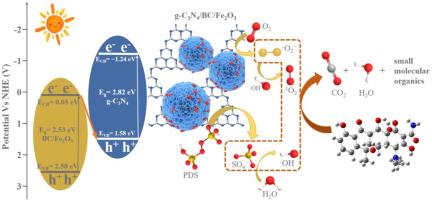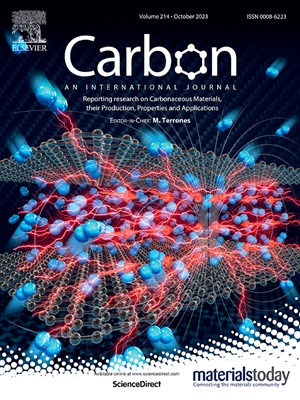磁性生物炭掺杂 g-C3N4/Fe2O3 S 型异质结通过添加过硫酸盐增强四环素的光催化降解能力
IF 10.5
2区 材料科学
Q1 CHEMISTRY, PHYSICAL
引用次数: 0
摘要
氮化石墨(g-C3N4)具有显著的热稳定性和化学稳定性,可有效激活分子氧并生成超氧自由基,从而实现光催化降解污染物。然而,g-C3N4 的比表面积低、光催化活性差,限制了其发展,而且污染物降解的反应机理尚不清楚。本研究将 g-C3N4、生物炭(BC)和 Fe2O3 紧密接触,合成了 g-C3N4/BC/Fe2O3 催化剂。在 g-C3N4/BC/Fe2O3-2/PDS 体系中,四环素(TC)的最高光催化降解效率达到 94.9%,分别是纯 g-CN4、BC 和 BC/Fe2O3 的 3.01 倍、1.53 倍和 2.35 倍。过硫酸盐(PDS)的加入加速了活性氧(ROS)的形成,提供了更多的活性物种,改善了光催化性能,从而提高了 TC 的降解能力。LC-MS 分析和密度泛函理论(DFT)计算用于阐明 g-C3N4/BC/Fe2O3-2/PDS 系统中可能的 TC 降解途径。电子顺磁共振 (EPR) 证实了反应体系中生成了多种 ROS,包括 h+、-OH、SO4--、-O2- 和 1O2。这项研究从机理上揭示了三氯甲烷的降解过程,为今后研究用于水处理的高级氧化过程奠定了理论基础。本文章由计算机程序翻译,如有差异,请以英文原文为准。

Magnetic biochar-doped g-C3N4/Fe2O3 S-scheme heterojunction with enhanced photocatalytic degradation of tetracycline by addition of persulfate
Graphitic carbon nitride (g-C3N4) exhibits remarkable thermal and chemical stability, enabling effective activation of molecular oxygen and generation of superoxide radicals for photocatalytic pollutant degradation. However, its low surface area and poor photocatalytic activity have limited its development, and the reaction mechanism of pollutant degradation remains unclear. In this study, we synthesized g-C3N4/BC/Fe2O3 catalysts by combining g-C3N4, biochar (BC), and Fe2O3 in intimate contact. The highest photocatalytic degradation efficiency of tetracycline (TC) reached 94.9 % in the g-C3N4/BC/Fe2O3-2/PDS system, which was 3.01, 1.53, and 2.35 times higher than that of pure g-C3N4, BC, and BC/Fe2O3, respectively. The addition of persulfate (PDS) accelerated the formation of reactive oxygen species (ROS), providing more active species and improving photocatalytic performance, thereby enhancing TC degradation. LC-MS analysis and density functional theory (DFT) calculations were used to elucidate possible TC degradation pathways in the g-C3N4/BC/Fe2O3-2/PDS system. Electron paramagnetic resonance (EPR) confirmed the generation of multiple ROS in the reaction system, including h+, •OH, SO4•−, •O2−, and 1O2. This work provides mechanistic insights into TC degradation and offers a theoretical foundation for future studies on advanced oxidation processes for water treatment.
求助全文
通过发布文献求助,成功后即可免费获取论文全文。
去求助
来源期刊

Carbon
工程技术-材料科学:综合
CiteScore
20.80
自引率
7.30%
发文量
0
审稿时长
23 days
期刊介绍:
The journal Carbon is an international multidisciplinary forum for communicating scientific advances in the field of carbon materials. It reports new findings related to the formation, structure, properties, behaviors, and technological applications of carbons. Carbons are a broad class of ordered or disordered solid phases composed primarily of elemental carbon, including but not limited to carbon black, carbon fibers and filaments, carbon nanotubes, diamond and diamond-like carbon, fullerenes, glassy carbon, graphite, graphene, graphene-oxide, porous carbons, pyrolytic carbon, and other sp2 and non-sp2 hybridized carbon systems. Carbon is the companion title to the open access journal Carbon Trends. Relevant application areas for carbon materials include biology and medicine, catalysis, electronic, optoelectronic, spintronic, high-frequency, and photonic devices, energy storage and conversion systems, environmental applications and water treatment, smart materials and systems, and structural and thermal applications.
 求助内容:
求助内容: 应助结果提醒方式:
应助结果提醒方式:


